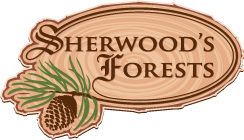Trees & Shrubs for Alkaline and Salty Soils
Life can be difficult...
Alkaline and salty soils often go together. They aren't quite the same problem
Alkaline clay soils tend to not have any structure to them. In summer they make good immitation of brick. They are nearly water proof.
For this discussion we're calling a pH of 8.0 alkaline.
Salt isn't just sodium chloride -- it's all the junk disolved in your water. Sodium is part of the picture, along with calcium and magnesium. The other side of the equation is mostly carbonate and bi-carbonate.
You can get a soil test kit at any garden centre to test for soil pH. You can bring a soil sample to me to have it tested for excess salts. Bring two samples: Each should be about a cup. (Cottage cheese or yogurt tubs work great) One from the top soil, and another sample from below the top soil -- usully a striking colour change -- about 8 inches down.
Ok. Let's make the problem more complicated:
Airborne salt.
- Aerial salts that land on foliage. Usually a problem close to highways, busy streets. In rural back roads salt generally isn't used except on steep hills and near stop signs.
- The bulk of damage occurs within 60 feet of the source. Very sensitive plants can be affected a thousand feet away.
- On leaf trees, the salt will kill buds and twigs. On evergreens, browning or yellowing of needles, often only on the road side. Sensitive evergreens affected up to 300 feet away.
Soil salt.
How much is too much? 1000 ppm (parts per million) is low. 1000-2000 ppm medium. Over that is high.
- Road runoff.
- Sidewalk/driveway runoff from de-icer use.
- Problem is made worse by poor drainage. Salt can't be flushed away.
Think you have a problem?
More information here: (Local copy) Plant Materials for Salt Affected Sites
Original source retrieved 11 March 2020 Plant Materials for Salt Affected Sites
Reducing soil salinity.
From University of Virginia Cooperative Extension Service
Numerous options exist for reducing salt damage including:
Improving soil structure, drainage and moisture holding capacity by adding organic matter.
Planting salt sensitive plants uphill or on berms where salty water will not drain or accumulate. Also planting sensitive plants at least 50-60 feet back from paving that may be de-iced.
Leaching the soil with thorough irrigation after salt exposure. Flush salt through the soil by applying 2 inches of water over a 2-3 hour period, stopping if runoff occurs. Repeat this treatment three days later if salt levels are still high.
Irrigating thoroughly (deeply) rather than watering lightly (shallow watering). For established landscapes, one inch of water applied once a week is generally adequate.
Mulching to prevent evaporation and subsequent build-up of salt in the soil.
Fertilizing only when a soil test or plant symptom indicates that fertilizer is needed, and then only at rates recommended by soil analyses and fertilizer labels.
Use materials such as sand, cinders, flyash, coarse sawdust as traction aids instead of melting ice off.
Anyway: Plants that have some tolerance for these conditions:
Fairly high salt levels.
Trees
- Amur Maackia
- Austrian Pine.
- Black walnut (but leaves poisonous to horses and many other plants.)
- Bur Oak, White oak. (Several oaks are listed. I suspect that most of the white oaks [round lobed leaves] will be at least moderately tolerant. Red oaks (pointy leaves) are mostly intolerant of pH above 6.8, but red oak is listed as salt tolerant.)
- Common mulberry
- Cottonwood (Populus deltoides)
- Douglas Fir
- Eastern white cedar
- Elms
- Hawthorn
- Honeylocust
- Hophornbeam (Ironwood)
- Laurel Leaf Willow
- Lindens (Basswood)
- Lilacs -- Japanese tree lilac.
- Pagoda Dogwood (Needs some shelter in our climate.)
- Serbian Spruce
- Siberian Crabapple (Probably many crabapples)
Shrubs
- Sea Buckthorn
- Golden Currant
- Common Lilac
- Caragana
- Saskatoon
- Silverberry
- Potentilla
- Phitzer Juniper
- Sumac
- Buffaloberry
- Snowberry
- Spirea
- Lilac -- both common and villosa
Moderate levels.
Trees
- Birch -- native paper birch. and several others not common here.
- Ash, green, and white
- Hackberry
Shrubs
- Eastern White Cedar (Arborvitae)
- Common Juniper
- Smooth sumac
Low Levels of soil salt
- Apple & Crabapple
- Norway Spruce
- Eastern White Pine
- Pin Oak.
Shrubs
- Viburnum -- High Bush cranberry
Intolerant
- Balsam Fir
- Maples -- Red, Sugar
- Pine -- Red pine
- Mountain Ash
- Basswood, Linden
- Hemlock
If you have to plant grasses, try wildrye and wheatgrass.
Seek Help!
I am far from expert on these matters. I don't have soils like this nearby. Many counties have a full or part time horticulturalist. Call your county office, and ask. They will know more about the soil issues in your area, and can give you more guidance.
As you find things out, let me know and I'll update this page.
Got something to say? Email me: sfinfo@sherwoods-forests.com
Interesting? Share this page.
Want to talk right now? Call me: (8 am to 8 pm only, please) 1-780-848-2548
Do not arrive unannounced. Phone for an appointment. Why? See Contact & Hours That same page gives our hours of operation.
Back to Top
Copyright © 2008 - 2021 S. G. Botsford
Sherwood's Forests is located about 75 km southwest of Edmonton, Alberta. Please refer to the map on our Contact page for directions.
